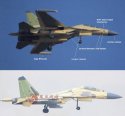Interesting ... there are a few more changes to the standard striker like the missing gun/cannon, a shorter radome, several dielectric / EW aerials ....
View attachment 22911
Interesting, the smaller radome in particular.
It seems like the smaller radome of the nose of the J-16D is consistent with the size, geometry and relative position of the radome (the "grey" part only) of the AESA J-11B demonstrator. Therefore I suspect the J-16D may be using the same or a similar design radar as what was tested on the J-11B AESA testbed.
That could have interesting implications for the kind of radar J-16D is using compared to the standard J-16...
It could mean the J-16D may be using the same or similar radar to the J-11D (which is also expected to use the same AESA from the J-11B demonstrator), or it may also mean J-16 and J-11D and J-16D may all share a common AESA design, but that J-16's radome was not modified like J-11D's and J-16D's were for their respective radars -- J-11D and J-16D both have smaller radomes in an absolute sense relative to J-16's radome, meaning the maximum size of their AESAs would be smaller than what could be mounted on J-16.
That in turn could imply the standard J-16 may be using a slightly larger AESA compared to J-11D and J-16D, or that all three aircraft have a similarly sized AESA of a similar or even same design, but that J-16 simply did not reduce its radome geometry to accommodate a slightly smaller array versus the maximum
... or it could be that J-16D and J-11D both use the same radar design (possibly a more recent AESA design) and that the standard J-16 may use a slightly older and thus larger AESA design.
...or the standard J-16 may simply have a larger and more powerful array versus that of the J-16D and J-11D given it is more oriented for A2G strike, and a more powerful array would allow for more detailed SAR mapping, GMTI, and generally more powerful A2G detection and tracking.
... or J-16, J-11D and J-16D may all use completely separate and unrelated AESA designs from each other, but I find that less likely, and I believe that at least two of the aircraft of those three share a common radar design.



